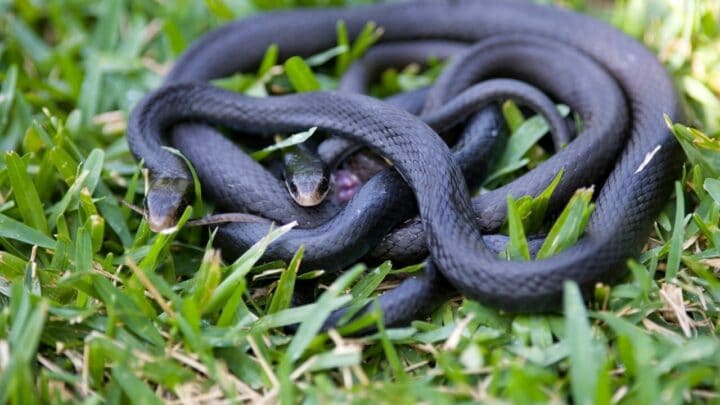Snakes mate in the spring after hibernation. If the snakes are being bred, they mate about a week or two after being brought out of the brumation.
Then, as a breeder, I introduced the two. If they take a liking to each other right away, I leave them in the same enclosure and let them be.
How Do Snakes Mate?
Female snakes use pheromones after waking up from brumation to attract male snakes. Once the male finds the female after following her scent, he intertwines his body with hers and enters one of his hemipenes into her cloaca. The two snakes may stay intertwined for up to 24 hours.
How Mating Works
The mating process starts with the male serpent his hemipenes into the female’s cloaca. Females have unfertilized eggs in an organ known as the oviduct.
The female also has two pockets to hold the male’s sperm. She decides when the eggs get fertilized.
She will lay the eggs roughly four weeks after they are fertilized. The female snake then lays an egg clutch that consists of two to eight eggs.
The eggs have a fluid-type coating over them that’s produced once the eggs are fertilized.
It acts like somewhat of a protective covering. The eggs will hatch in about eight weeks and the little baby snakes will emerge.
Most snake species are on their own after the female serpent lays her eggs. Unlike a lot of baby animals that are left to fend for themselves, the baby snakes seem to do alright.
All the instincts these snakes need to survive are already with them the day they’re born.
A female’s cloaca is very shallow (short) in comparison to a male’s cloaca. It must be longer to hold his two hemipenes. So, the male’s cloaca extends much farther down the tail than the female’s.
The length of the cloaca is how breeders tell the male and female snakes apart and make sure they have one of each.
When Snakes Mate
Snakes in tropical climates where the temperature doesn’t drop below 60 degrees Fahrenheit can mate any time of the year because they do not have to go into hibernation.
Snakes in colder climates where the temperatures do dip below 60 degrees Fahrenheit for an extended period are in the spring when the temperatures are continuously above 60 degrees.
Vomeronasal System
The male snake uses a sort of sixth sense, called the vomeronasal system. It helps with the identification of the pheromones.
Each female releases a different smelling pheromone. The male snake can tell if the pheromones are coming from a female of the same species, her size, age, reproductive sexual maturity, and condition.
This allows the male to consider her as a mating partner.
Once the male finds that specific female, he pushes his chin starting near the rear of a female snake, all the way up her body to her head.
He does this to make sure it is a female and if it is a female, the pheromones come from.
If the pheromones did not come from that female, and she is willing to mate, he would mate with her and then continue to seek the female he was searching for. Both male and female snakes can mate several times.
Many times, a female will choose the sperm from several different snakes to fertilize the eggs so she may lay a clutch of eggs from several different males.
Male’s Hemipenes
The male snake’s hemipenes must be stored inside his body in the cloaca to protect them. If they were on the outside of the body like many reptiles and animal’s sexual organs, they would be severely damaged.
As the snake slithers along the ground, they will be subjected to anything in his path including sticks, rocks, prickers from bushes, and anything else, and not only would this destroy them, it would be extremely painful for the snake.
So, nature got it right when tucking them inside and making them retractable.
How Long Snakes Mate: The Answer
Unfortunately, snakes don’t mate for life. However, some snakes (very few actually) will stick around and provide protection for the female and the eggs (if they are laid not live babies).
There is always an exception, though it is rare in this case.
Some male snakes will produce a mating plug after the mating process that blocks the female’s cloaca, so other males cannot mate with the female.
The plug is forced out when the snake releases the eggs or gives birth to live baby snakes.
Generally, both the male and female will leave the baby snakes once they hatch or are born if they stick around that long. Baby snakes know how to take care of themselves when they’re born.
Breeding and Mating
As a breeder, I breed the two same snakes especially when I know that the baby snakes are healthy. Mating snakes should not be disturbed.
It can cause harm to one or the other or even both snakes. Some snakes do become aggressive when mating is interrupted, so it is best to just let the snake’s mate and leave them alone.
Frequently Asked Questions about How Snakes Mate
Do female snakes lay their eggs through their mouth?
This is a myth. Female snakes do not lay eggs through their mouth. The eggs come from her cloaca, the same cavity in her body that waste is eliminated through. Snakes only have two openings, the mouth, and the cloaca.
How long can a female snake hold on to sperm before fertilizing her eggs?
They can store the sperm for up to five years and still have healthy viable baby snakes.
Conclusion
Snakes truly are amazing reptiles. Not only are they intelligent, but they are also born with the instincts they need to survive alone.
Snakes and the reproduction cycle seem rather simple, but it is more complex than most people realize – a female that can hold sperm and fertilize eggs five years later is an amazing animal.


